Link Building 2.0: The Leverage Flywheel
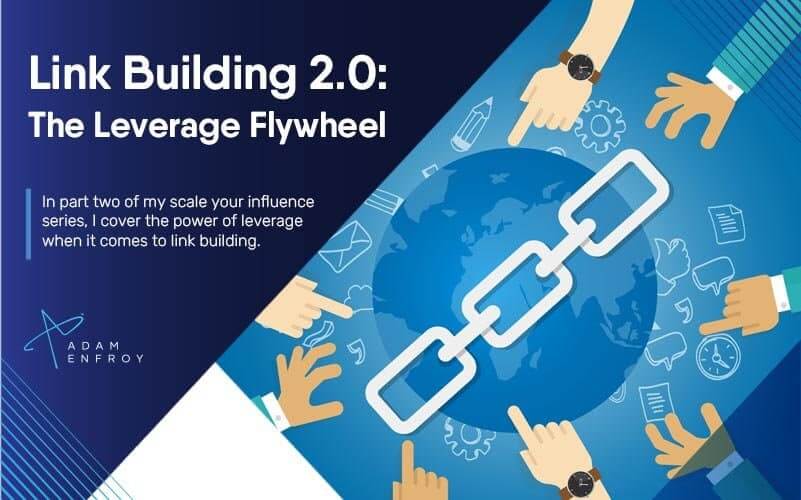
Links are the currency of the Internet. Are you wealthy or broke?
I’m sure you’ve read a ton of articles about link building strategies – guest blogging, broken link building, link reclamation, unlinked mentions, blog comments, HARO outreach, link partnerships, etc.
These articles typically tell you how to perform outreach, which tools to use, and different tactics to start building links.
However, they’re missing one key component.
Leverage.
Consider this.
Links are like currency. The more you have, the better your chances of ranking on search engines. And the better your chances of search rankings, the more potential money you can make.
There is an intrinsic value in obtaining a backlink.
And remember, the link’s value is directly tied to the Domain Rating (DR) of the site you’re gaining the link from.
DR is a metric created by Ahrefs (similar to Moz DA) that is a number from 0 to 100 based on your link profile and ability to rank on search engine results pages (SERPs).
- When you start a new blog, your DR is zero.
- Small blogs have DRs from 30-50.
- My current DR is 78.
- Major blogs have DRs in the 70s and 80s.
- Large SaaS companies have DRs in the 80s and 90s.
- The top sites on the Internet like Google, YouTube, and Facebook have DRs of 99+.
So how does this equate to value?
Well, a link from a small, niche blog with a DR of 25 is much less valuable than a high-quality link from The New York Times or Wikipedia with a DR of 90+.
Link value is passed from the linking website to yours. In other words, the higher the DR of the site linking to you, the more valuable it is.
These new links are votes of confidence in Google’s eyes. They show that your blog is trustworthy.
Backlinks are still one of the biggest Google ranking factors because they are difficult to obtain. They don’t magically appear; you have to work for them.
And they are valuable.
Think about this.
I’ve seen digital marketing agencies charge anywhere from $500 to $3,000 for a single high DR link.
If getting a few high DR backlinks can help you move to the first page of Google, and then make money from your post, these valuable links have a real market impact.
Why would a website give you this value for free without receiving anything in return?
It doesn’t make sense.
You can write the most magnificent, link-worthy post, perform perfect outreach asking for the ideal link placement – and you may still fall short.
Why?
There is nothing of value in it for the other party.
Ultimately, you’re asking somebody to do work on your behalf (add a link to their website) which benefits you and does nothing for them in return.
So what do you do?
You use leverage and provide value.
You create a real, mutually beneficial partnership.
This is what I like to call leverage-based link building and it’s something I came up with in 2020.
Using leverage-based link building in my blog’s first two years, I increased my Ahrefs Domain Rating from 0 to 78 and built links from 433 DR 70+ sites. Of these 433 sites, 44 of them had DRs over 90.
These sites are some of the highest authority sites on the Internet: Forbes, Business Insider, Entrepreneur, WP Engine, GoDaddy, Weebly, Yahoo!, HubSpot, BigCommerce, and more.
Getting backlinks from all of these sites made Google take me seriously. They helped grow my traffic from 0 to 500,000 monthly readers and increased my blog’s revenue to over $80k per month.
I don’t like to brag, but I do consider myself one of the best link builders in the world.
How did I do it?
Leverage-based link building.
This isn’t a low-quality tactic or black hat link building. It’s white hat link building on steroids, and not many brands or SEOs know about its power.
In this guide, I’ll cover what leverage-based link building is so that you can start implementing it for your own blog.
First, let’s cover some psychological reasons that links are tradable assets.
The World is a Value Exchange.
According to historical records, bartering began over 8,000 years ago as Phoenicians started trading their assets for food, weapons, and spices.
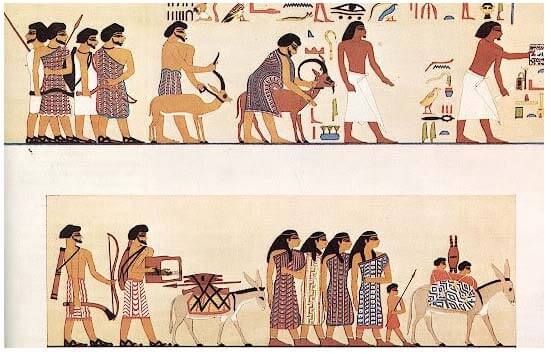
And with the advent of farming (and the shift away from the hunter-gatherer lifestyle), the goal became simple: create a surplus and trade it for scarcity.
This allowed farmers to feed not only their families but entire communities. They could trade their surplus crops for spices, weapons, fabrics – anything they couldn’t attain themselves.
Today, our capitalist system runs on value exchanges and the same principles apply:
- You spend your time at a corporate job, go home, and purchase something on Amazon. You trade away your money (abundance) for a product you can’t create yourself (scarcity).
- You swap goods on Facebook Marketplace and Craigslist.
- You invest in the stock market to buy shares of a company, providing today’s money for a potential future return.
- Hell, you might even mow your in-law’s grass or bring them dinner to get brownie points with your wife (are you really doing it out of the kindness of your heart?)
Bartering is almost ingrained in our DNA.
We value security and abundance over danger and scarcity. We trade away what we have in abundance to attain what is scarce.
It’s selfish, but in many things we do, we often ask:
What’s in it for me?
This system of bartering and trading value for value is exactly the same when it comes to link building and growing a successful blog.
Partnerships cannot be a one-sided exchange.
You need to find ways to provide value.
How Do You Provide Value in Link Building?
Much like trading goods in the physical world, you can also trade things of value in the digital world. To do this, you first need to understand what is actually valuable in the digital world.
So what’s valuable?
Well, from my experience working with ecommerce brands, agencies, SaaS companies, and bloggers, there is one thing coveted by all:
Links.
If you want to form an online partnership and get backlinks yourself, you need to be able to provide good links in return.
It’s that simple.
Again, it’s a value exchange – not a one-sided offer.
I can’t tell you how many outreach emails I get every week asking me to put a link in one of my articles to “improve the quality of my article, boost my SEO, or “help my readers.”
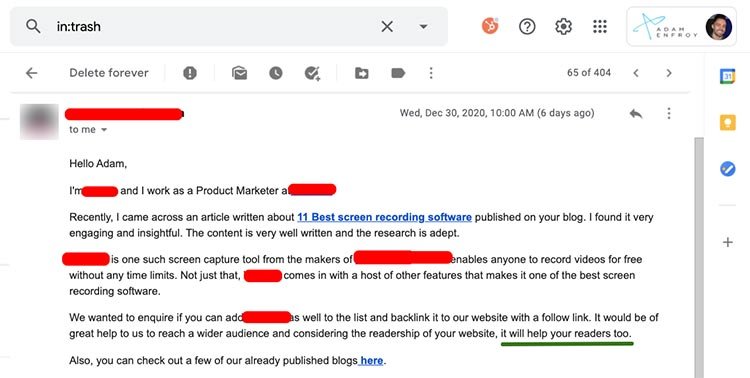
Or a blog will dangle the carrot of “add this link to your blog and I’ll share your post on social media” as if sharing a post to a few of their followers is somehow the same as a highly valuable backlink from my blog.
It’s not – these emails end up right in the trash. Again, what’s in it for me?
So what is a link worth?
Probably more than you think.
There’s no exact science to determining link value. It’s a combination of factors, including the site’s Domain Rating, niche, traffic, brand equity, etc.
If I had to make a totally and completely non-scientific estimate across all niches, I would say that one dofollow backlink is worth:
- DR 0-20: $50
- DR 21-40: $100
- DR 40-60: $200
- DR 61-70: $400
- DR 71-80: $500
- DR 81-90: $600
- DR 90+: $1,000
Ahrefs also did a study on the value of a backlink and found that the average value of buying a link was $352.92.
With this framework, you can begin to understand the value of links so that you can trade them more easily, and get more value in return.
The Myth of Passive Link Building.
Many search engine optimization experts and content marketers say that the holy grail of link building is “passive link building” – getting links to an article without doing anything because your post is just so good.
This link building tactic can be done by creating original research, adding infographics, videos, case studies, and writing quality content.
While all of the items above should be incorporated into some of your guest posts, passive link building is a myth in many ways.
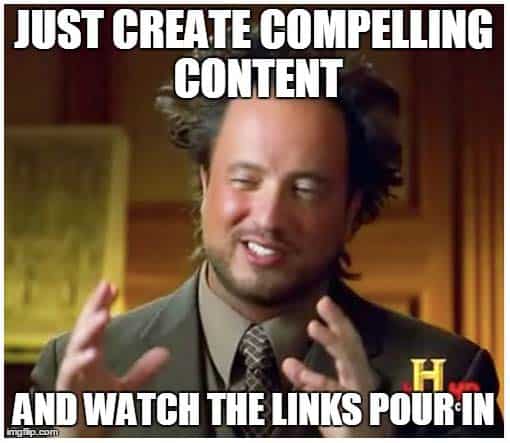
“Build it and they will come” does not work in 2021. Getting quality links is a flywheel that only rewards the most visible sites.
For example, let’s say you create an amazing article full of original research, infographics, and videos. It is by far better than anything ranking on page one of Google.
However, when you create a brand new article, it won’t start ranking right away. It might be on page 4, page 5, or it may not even crack the top 100 results.
Who’s going to find it?
The vicious flywheel of passive link building is based on visibility – sites that are already ranking get more links because they are easier to find.
Think about it.
A blog or news site is looking for a resource, so they Google it, find the answer quickly based on one of the top-ranking articles, and link to it.
It rewards the sites at the top.
While passive link building can work for popular, highly-visible sites, it is almost impossible for new bloggers.
Bottom Line: The idea of passive link building is a myth that keeps many new bloggers down.
So what do you do?
You need to take action and build Domain Authority yourself because no one else is gonna do it for you.
Other Factors in Determining Link Value.
Remember, not all links are created equal. There are a few tricky little details that you should know before you start link building.
Okay, so we know that a backlink is a piece of hypertexted anchor text that points a reader to your website.
How is this “link juice” passed from one site to the other?
There are a number of factors to consider, but here are the main seven.
1. Dofollow or Nofollow.
Links from other websites are either “dofollow” or “nofollow.”
Links are always dofollow unless marked otherwise. If a link is dofollow, Google search crawlers will “follow” the link to the external page and pass SEO value through it.
Nofollow links tell Google not to “follow” the link to the external page and to not pass any SEO value. Backlinks can be manually marked “nofollow” and this HTML tag is used in a lot of different (and often wrong) ways.
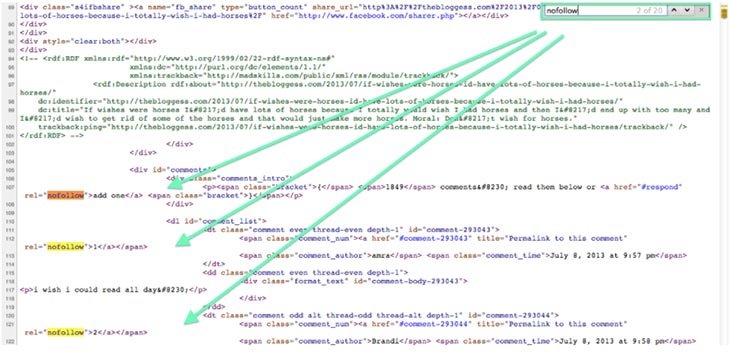
In a correct usage, affiliate links and sponsored links that are promotional in nature should be marked nofollow. If you’re citing a statistic, image, or helpful resource, they should usually be dofollow.
I often see blogs try to “save” link equity by marking too many external links as nofollow. The thinking is that if they mark all external links nofollow and all internal links to their own posts dofollow, then their blog posts get all of the link juice and more authority.
This is not completely true.
There are a lot of grey areas when it comes to dofollow/nofollow links and how they pass value.
SEMRush actually conducted a case study where they did witness some SEO value in nofollow backlinks.
Overall, it’s important to know the difference between the two types of links. Aim to get dofollow links for the most part, but know that there can also be SEO value in nofollow links.
It’s important that you have a natural mixture of both.
2. The Domain Rating of the Linking Website.
A link from a high DR website is more valuable than a link from a lower DR website.
This is true in almost all cases, except in some instances where there is a lower DR site with very few external links overall. In that case, a link from a lower DR site could be slightly more valuable if your external link is one of fewer total external links.
3. The URL Rating of the Linking Page.
Much like Domain Rating (DR) is the authority of an entire website, Ahrefs has another metrics that is very important in link building. That is the page’s URL Rating:

URL Rating is just like the DR, except it’s the authority of the individual web page, not the entire website.
When you publish a new blog post, the URL Rating is typically 10. This number grows over time as you build more links to this individual post.
While Domain Ratings of 70 and 80 are considered high, URL Ratings of 30 and 40 are considered high. URL Ratings are typically always lower than Domain Ratings.
So, in this instance, getting a link from a page with a URL Rating of 20 is more valuable than a link from a page with a URL Rating of 10.
4. The Relevancy of the Linking Site and Article to Your Niche.
A backlink from a site related to your niche can often benefit you more that a backlink from a completely unrelated site.
For example, if you wrote a blog post like my post on email marketing software, a backlink from Mailchimp would be way more valuable than a link from a random marketing blog.
5. The Number of External Links on the Linking Page.
Link authority is passed from one page to another. And the number of links on the page matters.
For example, if you get a backlink from a piece of content that has nine other links on the page (for a total of 10), then you’re getting around 10% of the link equity.
If you’re one of five links on the page, you’re getting around 20% of the link equity.
6. The Placement of the Link in the Linking Article.
External links that are higher up on the page pass more link equity than links lower on the page.
For example, if you get a link from an article within the first paragraph, that is usually more valuable than a link near the bottom.
This is also why you need to include your own links higher in your guest posts, as a homepage hyperlink in your author bio isn’t nearly as valuable.
7. The Anchor Text.
The anchor text, also known as the actual hyperlinked words that link to your site, is another factor in link building.
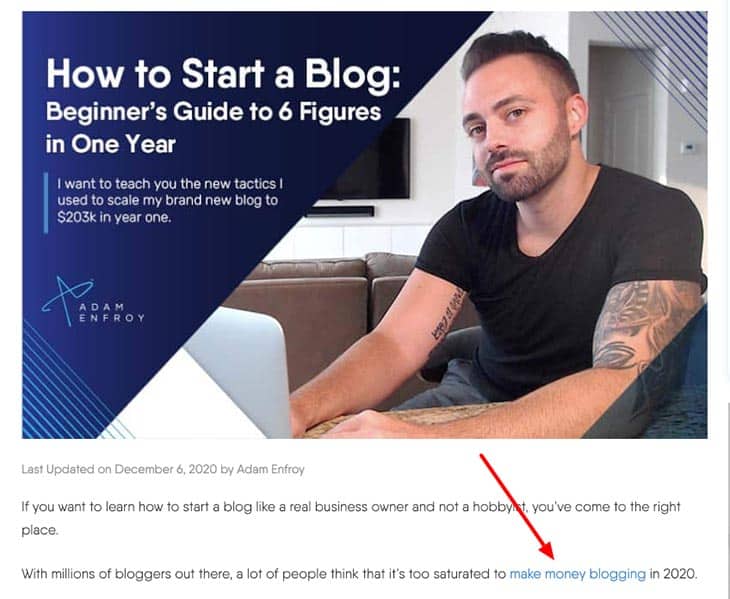
However, as Google’s algorithm and PageRank gets smarter and can read the contextual words around the anchor text, it’s becoming less important.
What is important is that your inbound links look as natural as humanly possible.
For example, if you get a link to your blog post on “how to make money online,”, you don’t want the anchor text to be “how to make money online.”
Instead, it should be a mix of one of five types of anchor text:
- Exact match – Anchor text that exactly matches your keyword (how to make money online). You don’t want many of these, as they are unnatural and wouldn’t occur that often without your input.
- Partial match – Anchor text that partially matches your target keyword (i.e., ways to make money). This is a strong type of anchor text to use because it’s more natural than exact match.
- Non-match – Anchor text that has nothing to do with your keyword (i.e., in this article). I like to use these pretty often, as they are the most natural-looking anchor text.
- Branded – Anchor text that aligns with your brand (i.e., Adam Enfroy). These are also good to use as it can naturally increase brand authority.
- Branded + Keyword – Anchor text that includes both your brand and your target keyword (i.e., Adam Enfroy’s guide to making money online). This type of anchor text is also good as it attaches your brand to your target keyword.
Summing it up: All of the factors above determine the value of an individual backlink. They are ranked in my personal order of priority and all should be considered if you want to truly understand how to build links.
So, to recap, the best possible link would be:
A dofollow link from a high DR website related to your niche on a page with a high URL Rating, placed highly in the article, with few other links on the page, with natural anchor text.
Confused? Don’t worry about it too much. This isn’t an exact science, but just some helpful things to know before you start link building and guest posting.
Now that we’ve covered some of the basics, let’s get into a few strategies.
Leverage-Based Link Building Strategies.
Here are some new leverage-based link building strategies that I started using with my blog.
1. Guest Post Link Trading.
Guest blogging is still one of the main ways for bloggers to get backlinks. The value of guest blogging isn’t getting referral traffic, but boosting your Domain Rating so that your content can rank.
This process involves reaching out to other blogs in your niche, writing a guest article for their website, and linking back to your own.
However, simply writing guest posts for links is not enough. Guest post links are also somewhat unnatural – if Google sees that every single backlink you get is from a guest post that you wrote, it might raise a red flag.
They may think that you’re the only one linking to your blog and you’re not getting enough “natural” mentions from other articles. You don’t want to come off as spammy or forced when building your backlink profile.
So how do you take guest blogging to the next level?
You use your guest posts as resource to obtain more backlinks.
Let’s take an example from my blog.
In November 2020, I published 12 guest posts on other sites in my niche.
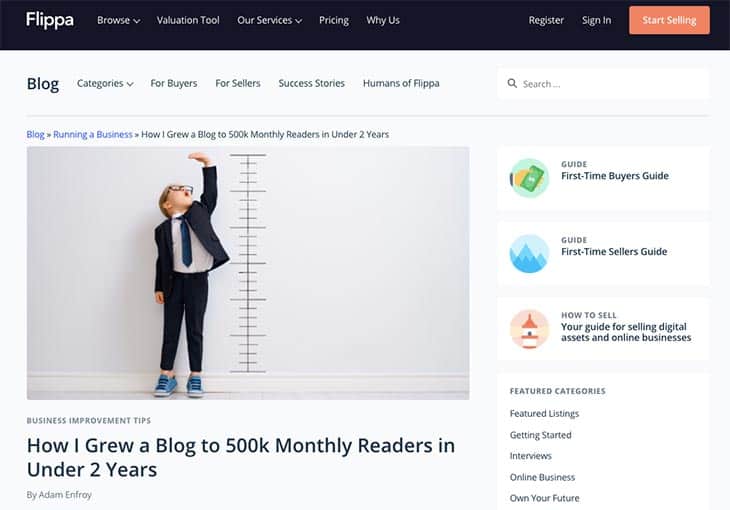
How did I optimize links in these guest posts?
Well, I added a few links to my site, a few internal links for the blog I was writing for, and a few helpful statistics.
But why stop there? What if there was room for more links?
If a link is worth $352 on average, why wouldn’t I add a few more and use that leverage to power more links for my own blog?
This is where guest post link trading comes in.
Here’s how it works: You find other bloggers in your niche who are also doing guest posts on high authority sites and trade backlinks to each other between your guest posts.
Since you already have room to add some extra links, you add theirs into your guest posts and they add yours into their guest posts.
It’s a win-win.
Instead of publishing 12 guest posts and getting backlinks from 12 websites, you can use your guest posts as trade bait and get backlinks from other author’s guest posts via partnerships.
However, you also don’t want to overdo it – these need to be high-quality links based on real relationships. If you read Google’s Webmaster Guidelines, there are a lot of things that can be considered a link scheme that you want to avoid.
The good news? It’s not too complicated to do this once you start doing a lot of guest post outreach. These partnerships come naturally as you meet other bloggers in your niche.
Value Exchange: You are providing links to another blogger and getting links in return.
2. Pre-Linking in Guest Post Outreach.
If you want to work with a top blogger or influencer in your niche, you can provide a ton of value by linking to them in your guest posts before you even reach out to them.
That way, in your guest post outreach email, you can showcase the valuable backlinks that you already sent them.
For example, I really wanted to work with Pat Flynn of Smart Passive Income. So before I reached out to him to do a podcast interview, I made sure to send him 10 backlinks from some of my guest posts.
This pre-linking strategy worked.
His team saw the value in the backlinks I provided, the podcast interview was conducted, and I got a few backlinks from the podcast episode’s page:
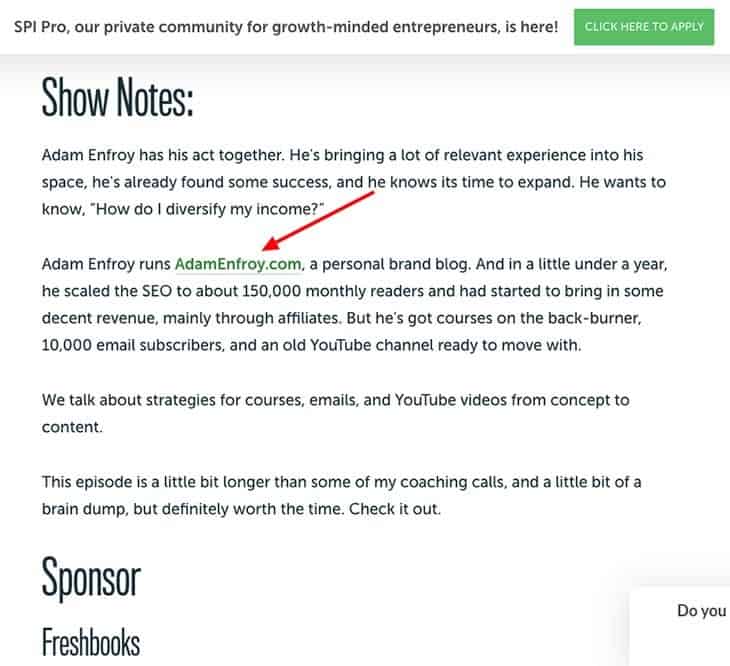
This is a pretty next-level strategy and one that is tough to scale. I’d try to use it once you have a decent number of guest posts in progress and want to gain opportunities on sites that may not normally answer you.
Value Exchange: Your providing links upfront in order to get high-quality future links in return.
Other Strategies
I can’t cover every leverage-based link building tactic I use to get traffic and make over $70k per month with affiliate marketing.
In fact, it would be foolish for me to provide this information for free online. I simply can’t afford to share these tactics with my competitors.
However, I will cover all of them in-depth in my online course that I will be launching in early 2021.
Link Building – FAQs
– Avoid sites with one too many Dofollow links.
– Linking to non-relevant websites.
– Building links with low-authority websites.
– Using links from low-quality/plagiarized content.
Some of the most common mistakes include the following:
– Not looking at search intent and on-page SEO beforehand.
– Having lousy outreach.
– Not creating good linkable content.
– Setting unrealistic expectations for users.
The three type of important links commonly found on websites are internal links, external links, and backlinks .
– Internal links are links leading from one page on your website to another.
– External links are links leading from your website to another external website.
– Backlinks are links leading from another website to your own website.
Summary
Links are a value exchange based on leverage.
It’s less about the individual link building technique and more about the value you can provide.
If you’re not providing value, even the best link building strategies can fall short.
Instead of crafting guest post outreach emails based on getting links, focus on showcasing value and giving links.
Instead of worrying about the perfect tactic like broken link building or link reclamation, focus on building a real, mutually beneficial partnership.
Scaling your authority in link building creates a snowball effect:
- The more links you get, the higher you rank.
- The higher you rank, the more traffic you get.
- The more traffic you get, the more passive links you get. This can help boost up your passive income.
And you have to start somewhere.
If you’re just getting started with link building, you have to hustle, build relationships, get guest posts, build a link surplus, and use your surplus to trade value in the digital world.
What do you think of this new form of leverage-based link building? Do you have any questions on link building?
Let me know in the comments below.


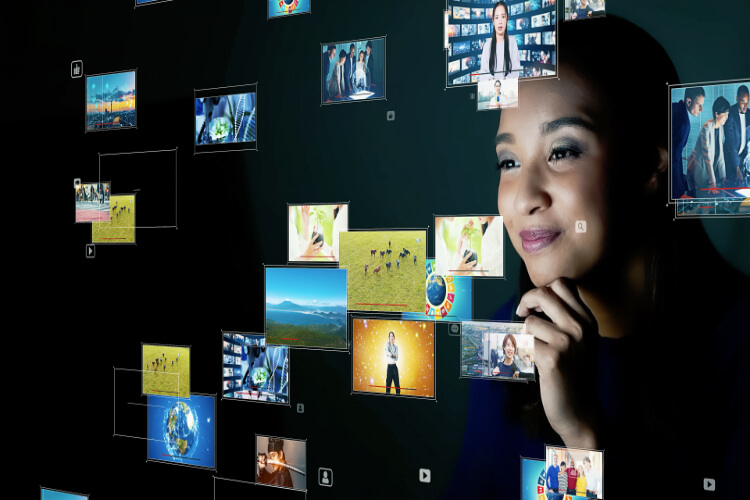



What are some realistic reply rates when reaching out to other blogs, especially with a low domain authority? I’m not having much luck on email replies and I’m wondering if I should follow up with a second email.
Hey Lily, good question. Yes, you should follow up with a second and third email days later. I think that a 50% open rate and 10% reply rate are pretty good. In some of my campaigns, I even see just a 5% reply rate, so it really is a number’s game.
Hi Adam,
I really enjoyed this article. Thanks for posting it.
I noticed that the link building strategies mentioned here are someway, only relevant to a site that already has some authority.
What would you say for a site that is totally fresh with a zero domain rating? What type of value can a new website provide to gain more links?
These strategies can still work for brand new blogs with a zero domain rating. The key is to get some guest posts going and then use those as leverage to share links and get more opportunities.
Hmm… I always feel Link Building is just to feed algorithm so that it can analyse quality sites. But link building is becoming challenging and time consuming as humans are involved in it.
Do you recommend any agencies for helping with finding guest posting opportunities? I’m actively looking for this.
Hey Grant, good question. For finding guest posting opportunities, that mainly involved list building (getting the site, name and email address of who to reach out to), then doing the initial outreach. You can get a VA or freelancer to do this for you rather than going with a more expensive agency. You need to be the one driving the strategy and telling your people what types of sites to go after, how to pitch topics, etc.
Hi Adam, once again, you have shared awesome stuff. Everything is new to us as bloggers. Usually how much time does it take for blogs to review a guest post. Especially, in your case?
Thanks. 🙂
I’d say that you typically have two weeks to write and submit a draft once a topic is approved. Then the time it takes to review and publish is entirely dependent on the blog editor that you’re working with. Some can go up as quickly as a few days, some take months. It’s important that once you submit a finished guest post, you follow up regularly (every few weeks).
Wow😍 what an amazing article once again on my top favorite blog…Thank you Adam…
This technique of Leverage-Based Link Building Strategies is amazing… Cleared so many doubts and created new way of thinking…
Specially I am very thankful for your 7 points of Other Factors in Determining Link Value topic this cleared many doubts…
One Question, please???
Are directory/ Article Submissions sites are worthful now a days?
Thanks! And no – I’d avoid directories and article submission sites that allow anyone to add their content.
What about part 3?
Really super excited, you are just amazing!
Part 1: Keyword Research
Part 2: Link Building
Part 3: ???
Please reply, that the pasrt 3 is based on which concept?
Can’t wait for it!
Love you
Part 3 is going to be based on monetization and affiliate marketing. 🙂
I love this article, it is so helpful and informative.
Thanks!
Thanks for sharing this link building post. It seems there are a lot of blogs that use Disqus for comment hosting. When you comment on this kind of blog, it creates nofollow link which is useless in terms of SEO. So we should avoid blogs with Disqus in this sense, shouldn’t we?
You should avoid trying to get links from commenting. That no longer works. Real relationships and in-content links are the only way to go.